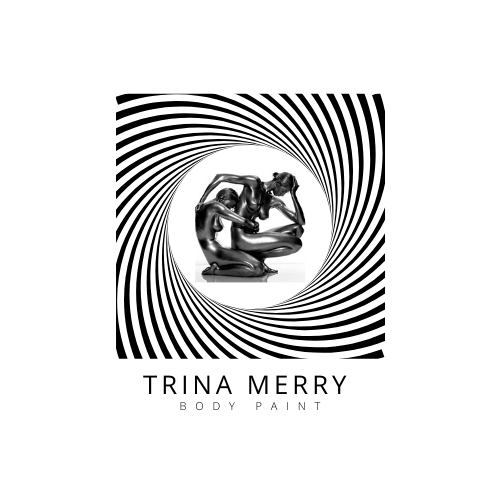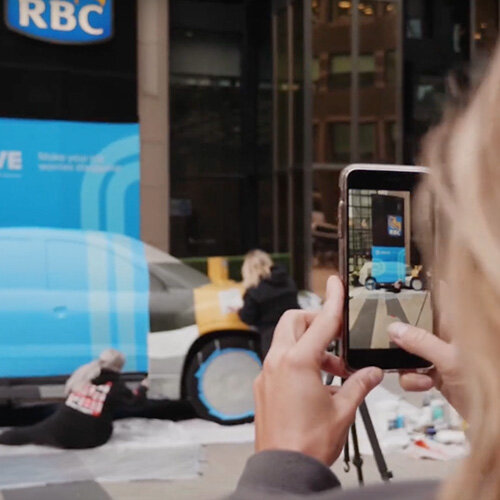RBC DRIVE App - Case Study - Experiential Art Marketing
Assignment
Ever seen a full-sized car disappear into a busy downtown bank without a scratch?
When RBC Ventures, a division of Canada’s leading financial institution contacted Trina Merry, the company, a subsidiary of the Royal Bank of Canada, had launched an app called DRIVE. In line with RBC Ventures’ focus of using technology to solve real-world problems, DRIVE ensures all car ownership and maintenance needs are covered in one nifty application.
Safely storing users’ key car ownership and insurance records, as well as an easy booking facility for the next oil change or fix, the DRIVE app is the intelligent tech concierge relieving busy drivers of the annoying bits.
Problem
Such an important product needed a grand entrance into the hearts and minds of more Canadian drivers.
Brand awareness – that was the number one goal for the project.
RBC Ventures needed to find a unique way to gain (and hold) the attention of car owners in Canada for long enough that they would want to learn about DRIVE and its numerous benefits.
More than just a publicity stunt, the app required a Canadian activation that (safely) stopped drivers in their tracks, drawing their interest and proving their engagement.
What creative method could RBC Ventures use to uniquely promote its new digital product, gain the respect of prospects immediately and maintain its stellar reputation and branding style?
No coincidence then that they came to world champion body painter and mixed media artist Trina Merry to deliver just the solution needed to solve these problems.
Solution
Led by the team at Send + Receive agency and Trina Merry, the DRIVE app was promoted in an artistic experiential campaign.
Located in one of Canada’s busiest pedestrian intersections, next to a transit hub where Toronto commuters come into the city from all directions, Trina Merry painted the body of a non-moving car, camouflaging into the city surroundings - symbolizing how DRIVE makes your car worries disappear.
Using camouflage art to build relationships between the brand and its consumers, this example of experiential marketing gets to the heart of what motivates people, positioning the brand as useful, interesting, relevant and desirable.
In front of RBC's HQ, Trina Merry draped the middle of the car in the company's blue brand colours. This was backed by green and silver paint to ensure the car matched the building behind it seamlessly.
As amazed passersby drew closer to the spectacle, they were met with RBC’s enthusiastic reps from DRIVE on site to demonstrate how the app works, encouraging people to download and use it for themselves.
Additionally, to add further visibility and reach of the campaign, DRIVE was promoted on TV in the Greater Toronto Area, a correspondent from popular Toronto news morning show Breakfast Television interviewed DRIVE reps and the art experience was shared online and across social media.
Unintentionally, the camouflage painting spectacle took place within a stone’s throw away from where the Toronto International Film Festival was taking place.
“This was a pleasant coincidence,” a RBC spokesperson said, detailing that they picked the location largely due to the 150,000 commuters from suburbs that enter the area every day.
“We also needed it early in the fall so that the weather would cooperate. That put us in the same week as the Toronto International Film Festival, taking place down the street from our event.”
The extra eyes of film fans added to the atmosphere of novelty and excitement covering the area during Trina Merry’s camouflage painting of the car.
“The most entertaining reactions were as we loaded in the unpainted but wrapped white car on the Saturday night during the film festival,” a RBC Ventures spokesperson said. “Several passers-by thought this was some installment from a movie, or something related to the film festival, so there was much curiosity!”
Results
This amazing event produced more than just fleeting curiosity, however. It enhanced DRIVE’s relationship with Canadian onlookers, as well as showing off the brand’s elegant, but creative streak. “The final product was unbelievable,” the RBC spokesperson remarked, “and the reactions from passers-by that saw it in progress and then came back to see the final “invisible” car.”
Was fascinating to see Trina’s process & to see the finished product coming together. Was also very fun to watch the commuters who walked by the work-in-progress car on their way to the office and then to see their reaction to the finished product on their way back to the train at the end of the day.
Although RBC are unable to share confidential numbers, they did confirm that the event did spark a number of existing users that had previously downloaded the app, to start using it again, and did drive some desired engagement, as well as achieve brand awareness objectives.
www.DRIVE.ca – Canadians can download the app and input your vehicle to find out if you have any recalls, to find out the resale value of your car, book service appointments and track important maintenance & insurance records for your car.
What is Experiential Marketing?
Experiential marketing is a marketing technique that creates experiences between brands and consumers. Experiential campaigns use an activation (for example product sampling, immersive experiences, stunts, events, etc.) to bring brands to life and interact directly with the target audience. The term activation means to turn on or start something or to energize a process.
EXPERIENTIAL MARKETING AND BRANDS
People are now more cynical about brands than they’ve ever been. Brands are struggling to remain relevant and meaningful by simply using traditional marketing communications. It’s time for a re-think.
Brands are struggling to create significant, long-lasting impressions in this digital age. Real world experiential marketing campaigns provide an opportunity to leave an impression, intrigue and compel consumers. Campaigns can span a range of executions/techniques from live experiences, to creative sampling, roadshows, festivals, social content, digital campaigns, PR stunts, partnerships, and much more.
Experiential marketing gets to the heart of what motivates people, positioning brands as useful, interesting, relevant and desirable. The best campaigns put people first, aiming to delight, provoke, challenge, inspire, motivate and, ultimately, produce tangible results. See some examples here.
Growing numbers of marketers are allocating more budget to experiential marketing, even over advertising. More than half of chief marketers will spend at least a fifth of their budget on experiential in the near future.
It’s not all plain sailing though. Many brands have reservations about experiential marketing, as it can be uniquely challenging to execute and get results from. Some commonly cited challenges include:
Difficulty measuring success
Reach too low
Lack of creative ideas
Not well targeted
Doesn’t drive advocacy
Won’t payback/ROI
WHAT ARE THE BENEFITS OF EXPERIENTIAL MARKETING?
In today’s society, people are more skeptical about brands than ever before. Coupled with the rise in social media, brands are required to be more transparent and work harder for people’s attention and brand love.
Experiential marketing techniques allow brands an incredible range of different creative ways you can truly connect with people in the real world. By delivering one-off, real-life engagement, interactions and experiences, you can start a conversation about your brand. This can be hugely impactful when compared to selling through simply pointing out key benefits in a one-way monologue.
Alongside this clarity of brand message, there’s also a higher tendency for wider reach as people are more likely to recommend a brand to family and friends following a positive brand experience.
WHERE DOES EXPERIENTIAL MARKETING FIT IN THE MARKETING FUNNEL?
Experiential techniques can work seamlessly with all other marketing channels, for example bringing to life an advertising campaign in the real world, sampling products, creating content or driving awareness of a launch with a PR stunt; it all depends on the brand, and the challenges being faced.
Brands often begin a campaign by choosing which media channels to exploit, then brief the matching agencies accordingly. This channel-focused approach can make briefing experiential agencies difficult since it has no preset format upon which to hang the expectations of a prescriptive brief. Recently however the fragmentation of media, combined with more sophisticated targeting, has seen the nature of client briefs begin to change. We have moved away from a media first, idea second approach, towards one where it’s the idea that comes first, and the media second. This is the perfect approach for experiential, because it leaves the brief open for a full range of possibilities to be explored, resulting in more effective campaigns.
HOW DO YOU MEASURE EXPERIENTIAL MARKETING?
There’s lot of different ways, but we start by questioning those who have interacted with the activity and then monitoring their behavior and interaction with the brand after the campaign. The activation needs to add value and move us closer to the goal and vision. The goal might be to bring consumers closer to your brand, to create awareness and drive engagement, to gain key press, increase social media mentions and website visits or to simply entertain and create a memorable experience that can be related to an event or brand.
IS EXPERIENTIAL MARKETING EFFECTIVE?
Absolutely, the key criteria is to keep the learning curve to near zero for any activation. We want to engage consumer and event guests with activations that capture their attention and draw them in. For this to happen the activation must be easy to use. While there may be complex technology elements in play, the focus has to be on execution of the final product that will require very little knowledge in order for the activation to be successful. The goal is to create fresh new experiences the excite, and illicit comments like “wow, cool, what is this, how do you do this?”
HOW DO I COME UP WITH IDEAS FOR AN EXPERIENTIAL MARKETING CAMPAIGN?
That’s where we can help. The client often has no ideas about the possibilities and capabilities and is likely limiting themselves by their knowledge level of what’s possible. We often hear the words new, cool, different, unique and innovative to try and describe what they are seeking. The descriptions are often a bit nebulous. They will know it when they see it kind of thing. This is where it’s important to combine elements from past experiences along with the knowledge of what’s possible, to assist the client in the creating of their vision that meets their goals and is achievable.
Every campaign should be developed by first looking at what the brand needs to achieve within the marketplace, and in their organization, along with reaction or action being sought. Therefore, a brief focusing on the business problem and media neutral; this open approach will allow your agency to deliver a strategy and creative that is truly unique to your circumstances. The activation needs to add value and move us closer to the goal and vision. The goal might be to bring consumers closer to your brand, to create awareness and drive engagement or to simply entertain and create a memorable experience that can be related to an event or brand.
Your budget will play a role in just how creative you can be with your experiential marketing campaign, although not the factor. If you’re looking for ideas, guidance or just someone to throw some of your concerns at, get in touch with us today.





